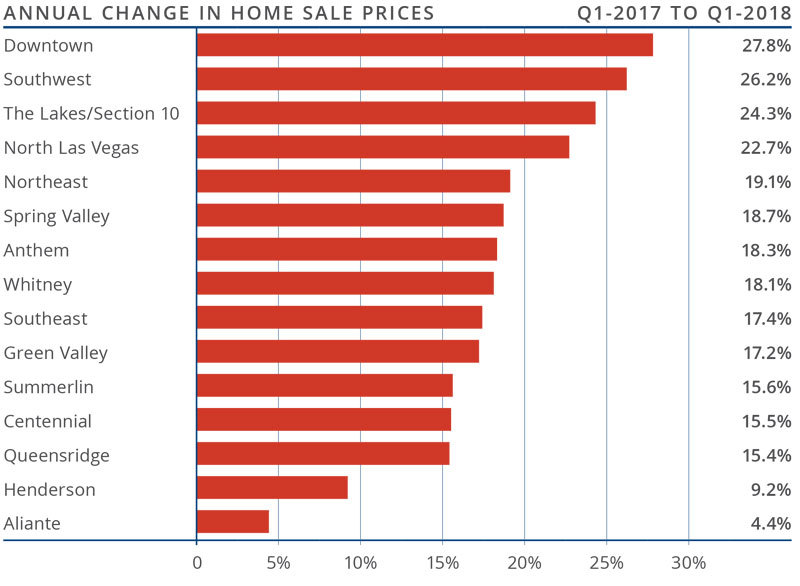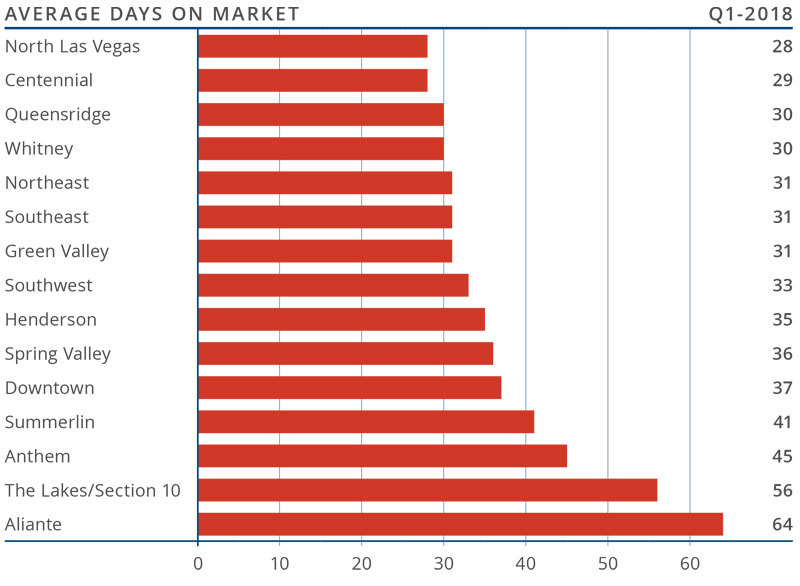The following analysis of the greater Las Vegas, Nevada real estate market is provided by Windermere Real Estate Chief Economist Matthew Gardner. We hope that this information may assist you with making better-informed real estate decisions. For further information about the housing market in your area, please don’t hesitate to contact me.
ECONOMIC OVERVIEW

Employment in the Las Vegas metropolitan area maintained the same growth rate as the final quarter of 2017, with year-over-year employment up by 2.7%. Over the past 12 months, the area has added 26,300 new jobs. This job creation has led the seasonally adjusted unemployment rate to measure 5.1%. This is the same rate as a year ago due to growth in the civilian labor force.
As the region nears full employment, I expect wages to continue rising at above-average rates, which should result in further increases in home prices as we move through 2018.
HOME SALES ACTIVITY
- A total of 7,955 homes sold in the first quarter of 2018—a modest 0.3% increase over the same period a year ago. With an increase of just 1.0% in pending sales, I expect there to be slightly more closings in the second quarter of this year.
- While total closings slowed relative to the final quarter of 2017, I believe this is due to the increase in mortgage rates that started last fall, which likely pulled some sales forward as buyers bought earlier to lock in better rates.
- Sales rose substantially in the Henderson and Spring Valley sub-markets, where transactions were up by 19.1% and 16.3%, respectively. Several other sub-markets saw positive sales growth, but total closings were down by 2.0% compared to the fourth quarter of 2017.
- Inventory levels remain remarkably low, with 32.5% fewer homes for sale than in the same period in 2017. Unfortunately, there was not a bump in new listings in early 2018, furthering the imbalance between supply and demand.

HOME PRICES
- Home prices in the area have risen by 18.4% year-over-year to an average of $291,386.
- Notably, only two neighborhoods saw annual price growth of less than 10 percent.
- Prices rose by double-digits in all sub-markets except two when compared to the first quarter of 2017. The strongest growth was in the relatively affordable Downtown sub-market, where prices were up by 27.8%.
- I predict that above-average price growth in the greater Las Vegas market will continue through the balance of this year. Strong job growth—in concert with limited inventory and favorable borrowing rates—continues to drive demand for housing.

DAYS ON MARKET
- The average time it took to sell a home in the region dropped by 12 days compared to the first quarter of 2017.
- The length of time it took to sell a home dropped in all but one of the sub-markets compared to a year ago. The exception was the Lakes/Section 10 sub-market.
- The greatest drop in days-on-market was in the Whitney sub-market, which fell by 18 days when compared to the same quarter in 2017. Homes in this area sold in 30 days on average.
- It took an average of just 37 days to sell a home in the first quarter.

CONCLUSIONS

The speedometer reflects the state of the region’s housing market using housing inventory, price gains, home sales, interest rates, and larger economic factors. Employment growth in Clark County is still very buoyant. This, combined with low inventory levels and competitive interest rates, will continue to push home prices higher. Given these factors, I have moved the speedometer a little further in favor of sellers.

Mr. Gardner is the Chief Economist for Windermere Real Estate, specializing in residential market analysis, commercial/industrial market analysis, financial analysis, and land use and regional economics. He is the former Principal of Gardner Economics, and has more than 30 years of professional experience both in the U.S. and U.K.
 Facebook
Facebook
 X
X
 Pinterest
Pinterest
 Copy Link
Copy Link



